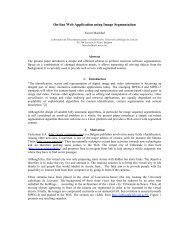motion estimation and compensation for very low bitrate video coding
motion estimation and compensation for very low bitrate video coding
motion estimation and compensation for very low bitrate video coding
Create successful ePaper yourself
Turn your PDF publications into a flip-book with our unique Google optimized e-Paper software.
Introduction 9<br />
<strong>motion</strong> eld that is more di cult to encode e ciently. This analysis is<br />
detailed at the beginning of Chapter Four <strong>and</strong> leads to the hypothesis<br />
that voluntarily simplifying the contents of the images to code could<br />
be pertinent. The <strong>motion</strong> <strong>estimation</strong> would then be per<strong>for</strong>med between<br />
two images with the same characteristics in terms of the accuracy of the<br />
contents description, <strong>and</strong> it is expected that the resulting <strong>motion</strong> eld<br />
will be easier to encode.<br />
This idea of pre-processing is rst <strong>for</strong>malized with the help of the Rate-<br />
Distortion theory: both intra-<strong>coding</strong> <strong>and</strong> pre-processing are modeled as<br />
the combination of a <strong>low</strong>-pass lter <strong>and</strong> additive white noise. Conditions<br />
<strong>for</strong> improving the coder per<strong>for</strong>mances are derived from this model. The<br />
in uence of various types of pre-processing on <strong>coding</strong> image sequences<br />
with the ITU H.263 st<strong>and</strong>ard is then experimentally tested. These preprocessings<br />
are: intra-<strong>coding</strong> <strong>and</strong> Gaussian, median or morphological<br />
ltering. Prospects are also <strong>for</strong>mulated <strong>for</strong> selective pre-processing according<br />
to the contents relevance.<br />
The aim of Chapter Five, which focuses on <strong>compensation</strong>, is to demonstrate<br />
that it is possible to subjectively improve the result of the <strong>motion</strong><br />
<strong>compensation</strong> stage (at the decoder) without modifying the <strong>estimation</strong><br />
(at the encoder) nor the transmission (the bitstream) 1 . This is possible<br />
by taking the spatial contents of the reference image into account in<br />
order to adapt the <strong>motion</strong> in<strong>for</strong>mation to it.<br />
The warping image techniques that have been described at the end of<br />
Chapter Two o er such a possibility, namely to easily adapt the <strong>motion</strong><br />
in<strong>for</strong>mation on irregular grid. However, their <strong>estimation</strong> phase is <strong>very</strong><br />
e ort-dem<strong>and</strong>ing because of its iterative nature. On the contrary, the<br />
BMA reveals itself a <strong>very</strong> e cient <strong>estimation</strong> method while its <strong>compensation</strong><br />
stage generates an image that su ers from so-called \blocking<br />
artifacts". We do thereafter suggest to use an asymmetric scheme that<br />
consists in a BMA <strong>estimation</strong> <strong>and</strong> a warping <strong>compensation</strong>. The warping<br />
technique involves meshes made out of triangular patches (that ensures<br />
a direct link with the a ne trans<strong>for</strong>m). Moreover, warping techniques<br />
(should they use triangular, quadrilateral or other structures) are <strong>very</strong><br />
well-suited <strong>for</strong> further editing <strong>and</strong> modi cation of images, manipulations<br />
that an increasing number of users like toachieve.<br />
1 Of course, if one wants to use the proposed reconstruction scheme in the <strong>coding</strong><br />
loop, it has to modify the coder so as to include the developed tool, which in turn<br />
will modify the contents (not the structure) of the bitstream.





